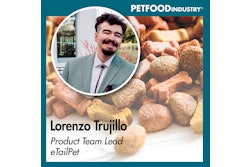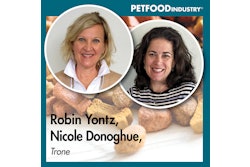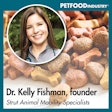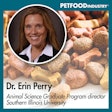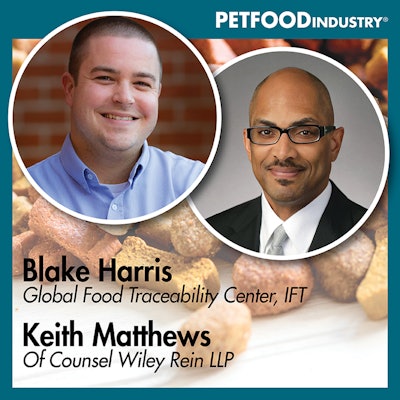
Blake Harris, technical director of the Global Food Traceability Center with IFT, and Keith Matthews, former American Bar Association Representative at the Council for Agricultural Science and Technology and Of Counsel at Wiley Rein LLP.
The below transcript is from Episode 52 of the Trending: Pet Food podcast where editor Lindsay Beaton spoke with Blake Harris, technical director of the Global Food Traceability Center with IFT, and Keith Matthews, former American Bar Association Representative at the Council for Agricultural Science and Technology and Of Counsel at Wiley Rein LLP, about the current state of food traceability and where it’s headed. You can find the episode at PetfoodIndustry.com/trending-pet-food-podcast, on SoundCloud or on your favorite podcast platform. This episode originally aired on January 4.
We want to thank AFB International for sponsoring this podcast. AFB is the premier supplier of palatants to pet food companies worldwide, offering off-the-shelf and custom solutions and services that make pet food, treats, and supplements taste great.
Lindsay Beaton – Editor, Petfood Industry magazine and Host, Trending: Pet Food podcast: Hello, and welcome to Trending: Pet Food, the industry podcast where we cover all the latest hot topics and trends in pet food. I’m your host and editor of Petfood Industry magazine, Lindsay Beaton, and I’m here today with Blake Harris, technical director at the Global Food Traceability Center with IFT, and Keith Matthews, former American Bar Association representative at the Council for Agricultural Science and Technology and current Of Counsel at Wiley Rein LLP.
Beaton: Hi, guys, and welcome.
Blake Harris, Technical Director of the Global Food Traceability Center with IFT: Hey, Lindsay.
Keith Matthews, former American Bar Association Representative at the Council for Agricultural Science and Technology and Of Counsel at Wiley Rein LLP: Thanks for having us.
Beaton: In case you're not familiar with my guests and their organizations, here's what you need to know. With over a decade of experience in supply chain-related functions at private sector and NGO organizations, Blake specializes in standards and process improvement, digital solution development and implementation and values working through complicated problems to develop effective and simple solutions.
In his role as the technical director at the Institute of Food Technologists Global Food Traceability Center, he's focused on improving the digitization of data in food systems through collaborating with a diverse set of stakeholders from industry, government and nongovernmental organizations.
Keith has practiced environmental law focusing on the regulation of chemical substances for over 25 years. He has practiced in the private sector and, for over 13 years, was a staff attorney and assistant general counsel in the Office of General Counsel at the US Environmental Protection Agency, first in the Air and Radiation law office and then in the pesticides and toxic substances law office. He also served for four years as the director of the biopesticides and Pollution Prevention Division in the EPA’s office of pesticide programs.
As Of Counsel with Wiley Rein LLP, Keith’s practice focuses on the regulation of chemical products in ag biotech, including genetically engineered organisms regulated by EPA and the US Department of Agriculture. Keith counsels and advises his clients using his breadth of knowledge on a variety of statutes related to chemicals regulation.
IFT is a global organization of approximately 12,000 individual members from more than 100 countries committed to advancing the science of food. Since 1939, IFT has brought together the brightest minds in food science, technology and related professions from academia, government and industry to solve the world's greatest food challenges.
The Council for Agricultural Science and Technology, or CAST, is a nonprofit organization with its membership composed of scientific and professional societies, companies, nonprofits and individuals. Through its network of experts, CAST assembles, interprets and communicates credible, balanced science-based information to policymakers, the media, the private sector and the public.
In September of 2023, IFT and CAST released a traceability issue paper focused on improving food safety and security in the food and agriculture communities, which is why I have brought both Blake and Keith and all of their experience on today to answer this question: What is the current state of traceability in the food industry? And where's it headed?
The first question that I want to ask has to do with traceability and consumer awareness because it's a hot topic in the pet food industry right now. The average pet food customer is asking more and more about things like ingredient traceability and where every part of their pet's food comes from. How does that awareness equate with what you guys see in terms of general consumer awareness of traceability?
Keith Matthews, Of Counsel, Wiley Rein LLP: And that's an excellent question. Before we delve into that, if I could provide just a little bit of background on the paper and how the paper came about, I think that might be helpful to the audience because this paper is really an outstanding work product, which represents the intellectual capital of some of the finest minds in the United States related to food traceability and food traceability issues.
Now, with respect to CAST, as you indicated, CAST is an agglomeration of organizations that come together and focus on issues related to agricultural science and technology. I served as the American Bar Association representative to the CAST food workgroup for a number of years. My day job is with Wiley Rein -- has been since 2017 -- but Wiley Rein was very accommodating in allowing me to put a fair amount of time into some of the issues that CAST has addressed over the past couple of years, one of which was food traceability.
The way the paper came about was that as part of my work on the food work group, I championed the idea of CAST doing a very well researched and informed discussion of where the science of food traceability stands and where it's going. I was tasked with doing the initial research from developing an outline of the paper. As I started to do that research, I realized that 75% of the information that I'm getting derived from IFT. IFT has done just an awful lot of excellent work over the years related to food traceability.
CAST executive vice president at the time, Kent Schescke, reached out to IFT and that's how this paper came about as a collaboration between the two organizations. CAST doesn't oftentimes do their papers in terms of collaboration. The bottom line is, we would not do justice, to food traceability without being involved with IFT. Because as I said, they are the gold standard for food traceability, and have been for many years in terms of the development and some of the best thinking that's gone into how to develop effective and useful food traceability systems. With that, I'll say that it's been a pleasure and a privilege to work with IFT on developing this paper.
To address your question, however, when I was doing the research, what I discovered is that food traceability, quite frankly, is more a regulatory and business issue than it is a consumer issue. Our public health regulatory agencies recognize that there's just a huge number of foodborne-related illnesses that occur on an annual basis in the United States. This is something that I think really kind of flows under the general awareness of the general public. They may get food poisoning from a fast-food restaurant or from contaminated vegetables in a supermarket or whatever. Most people get sick, they know they have a bug. They don't know what it is, they don't know where it came from, you know, they're sick for two or three days, then it passes, and they get on with their life. Where we really get serious foodborne-related illness incidents is when these incidents result in people going to the hospital or, heaven forbid, people dying.
Then it becomes a public health issue. The public health agencies get involved; they start to track it. There's the FDA has a website that tracks foodborne-related illnesses. These always address people who are very sick and some people who have died. But for the most part, I don't think and, you know, the data will show that's only a bare minimum of the number of actual foodborne-related illnesses that occur in the United States on an annual basis.
From that perspective, I'd say it's more a regulatory and business issue, because of course, a company runs the risk of being sued. If somebody dies from eating your hamburger, than somebody is probably going to want to sue you, so companies want to limit that liability. They really need to understand what's going on in our food supply when we're part of that supply chain.
Beaton: So really, it sounds like overall, the goal of traceability is to make sure that traceability is never a consumer problem, that it's part of the system and handled. Really, the onus of it all is among the businesses and the regulatory agencies to make sure everybody's working together properly and on the same page about what traceability is, what it means, what processes need to be in place, so that it's not anything consumers ever need to even have on their radars.
Harris: In addition to thinking about food safety, and it sounds like this may resonate with the folks out there with pets and pet food is … a claim made against a product, right? Whether that claim be sustainability or some sort of socially conscious claim on a product, I think that a consumer just assumes, “okay, well then you must know where this thing came from, if you're going to make a claim to it.”
That kind of a mindset in terms of traceability, if not, oh, this is a tradable product, because these food supply chains are extremely complex. Really the traceability mechanisms that are put in to assure such claims are very dependent on the claims that are being made.
Keith -- let me circle back and thank you for the glowing remarks on IFT thought leadership in the space. You know, we really started our work back in the 2000s with the Food and Drug Administration, in doing research and pilots with food industry folks. Through this research, through the pilot, we issued several different reports really pushing forward the concept of events-based traceability, which a general consumer is not going to know the definition of, but this is really helped to shape regulatory requirements.
When we see the FDA just rolled out a new Food Safety Modernization Act, Section 204, also known as their food traceability rule, last year, it was based on these concepts that were developed by IFP back in the 2000s. This is kind of going back to consumers assuming things are working correctly, and regulatory agencies adapting their approaches to try to shore up issues that maybe they see in traceability-related issues.
As these markets change, where are we get our food from now is different from where we got our food from 20 years ago. The supply chains have grown, they're more globalized. And they are much, much harder to track, to understand that from a food safety perspective, from an environmental perspective, really, from any sort of claim that's being made. I think that's really the lens that consumers are looking at traceability, whether they know it or not from when they're buying their product.
Beaton: I want to follow that thought a little bit more, because it's something you said in the paper as well, that supply chain is a vast oversimplification of what it would actually look like if you tried to put all of this stuff down on paper. It's not a chain. It's not one link to the next link to the next link. It is at best, a web with things going everywhere, and it's only getting more complex as time goes on. I'm sure the last few years have done some very interesting things for traceability in terms of being able to find supplies, and when there were transportation issues in supply chain issues and being able to find ingredients, being able to source foods. What has that been like, and how has traceability evolved? What does it look like right now?
Harris: Yeah, supply chain is not an appropriate representation of what really happens in these food systems. It is much more of a supply web. I think as regulatory agencies and industry have thought more about this, going back to FSMA, they're putting pressure on industry that, you know, when the 204 is enforced in January 2026, industry is going to be required to submit an electronic portable spreadsheet with all the data that FDA set out as a requirement for them to pass on within 24 hours.
This is a huge leap for some organizations in these food systems, but it's going to really help the FDA do these trace-back investigations when there’s an outbreak. There's other instances and other commodities that the industry is kind of taking the lead on things. One of the longest running projects that the Global Food Traceability Center has been working on is called the Global Dialogue on Seafood Traceability. It came out of work with the World Wildlife Fund, and the need to address illegal unreported and unregulated seafood in the seafood industry, which the UN estimates is up to 30% of all seafood -- so it's a huge chunk. It's a huge issue, particularly around something like sustainability of fisheries, right? We need to protect our oceans.
So, they came together and -- using this traceability model -- mapped out the critical tracking events, which are the different activities that happen across the supply web, the key data elements. What are the data points that everyone doing these different activities are responsible for collecting, so that we can have traceability from one end of the supply chain to the next? It really takes that level of standardization to push for interoperability of digital systems.
I know I'm probably going a little bit deep now, but basically, that's what we're working for, right? I think that the sortable spreadsheet that's required by the FDA is a step in that direction. The reality is that the amount of data, the amount of inputs from the amount of suppliers in this food web today can only be handled by digitally assessing this information, receiving and passing this on to customers. So maybe getting a little bit ahead of ourselves as to where we think this industry is going, and we're not there today, but it's certainly heading in that direction. It is absolutely, if not something that consumers have been talking about, absolutely it is a high topic of conversation, not just for industry, but really for a lot of the food system stakeholders.
Matthews: And Lindsay, I would say that Blake has made an excellent point there. As I said, when I first started to develop the outline for the paper, I really focused on the human health and food safety aspects of traceability. But as Blake points out, there's a tremendous right-to-know component to it. Seafood is a perfect example, because I'm not going to say a number because I'll get it wrong.
I remember a couple of years ago, there were reports about the amount of mislabeled seafood that is in the marketplace. Seafood that is labeled as one fish and is another type of fish. You go into a restaurant and think you're getting a certain type of fish -- pay a premium for it, when in fact, it's a lower quality type of fish. IFT, of course, again, has been at the forefront of seafood traceability. That's just an example of where the consumer right-to-know aspect of food traceability comes in.
Beaton: You said that was a very long running study and thing that you're doing. Have things been learned in that arena that can expand out to other food industries, in terms of what traceability should look like, what processes are maybe not in place that should be or legacy processes that are hindering the overall digitization of all this information? How has that connected or expanded into larger things? Or is every industry kind of in a silo?
Harris: Yes, there certainly have been things learned along that journey. We started working on this with WWF in 2012-2013, officially launched the dialogues in 2017. But the reality is, these are complex supply chains with folks that have a wide range of technical understanding about traceability in general. There's a lot of education that you must do there, around what are traceability, best practices, and then also thinking about the digitization of that traceability data and kind of building toward a world in which we can have a fully digitized supply chain.
It takes a lot of consensus building, because you don't do traceability just for traceability, right? There's some reason that you want to know where something came from, so aligning everyone's understanding of “this is why we're doing it.” This is why this is important and making sure that you have then the data that's being required to measure your impact.
Why are we doing this? We want to know X. Okay, what data do we need to know to measure where we are now and to measure our advancements toward reducing that issue or increasing it, whatever it is. There's a lot of consensus building, working with a wide variety of stakeholders better involved education, and then implementation, of course, is going to be an absolute critical aspect of it in providing resource and knowledge, providing business cases, to really get the momentum going in that direction.
Every food commodity is certainly different, in some ways, but they're all very much the same when trying to tackle the traceability concern.
Beaton: Are there certain segments of food or agriculture that are more on the ball than others? Is everybody kind of on the same level when it comes to their current state versus where you want them to be? Or are there some segments that, for one reason or another, have jumped ahead and are more digital or seem to have things on better lockdown that could be an example to other industries trying to get it together?
Harris: I would say the work in terms of creating a digital data standard is in the seafood. I've not seen parallel there. Obviously, it's a huge industry and it's not necessarily implemented everywhere. I would say that it's not even necessarily like commodity to commodity because within certain commodity sectors, you have higher value products. Certainly that's where people focus on -- where is the higher value product? I want to make sure that there is not some fraud creeping in here.
If I've got a high-value product, I want to make sure that the claims the final retailer -- whoever the final point of sale to the consumer is -- can confidently say this is what I say it is and not some fraudulent product that's entered the market. I would say more of the high-value commodities are really focusing on this, because they're the reason for it, they’re the reason behind and they want to make sure that there's consistency in their product.
Matthews: Blake, I want to ask you a question related to that question and see what your thoughts are on this because I think that another food segment where this has become increasingly important is leafy greens -- and this gets back to food safety -- because of the prevalence of foodborne illness incidents that have been traced back to leafy greens as Lindsay indicated at the very beginning.
I worked with several companies that produce genetic-engineered products. There's a company, Pairwise, that has genetically engineered leafy greens to produce additional anthocyanins so that your leafy greens are even more healthy for you. They provide you with a higher concentration of antioxidants, so even more reason to eat your vegetables or eat your salads. When I was talking with them, it occurred to me that this is going into an area just because of the number of incidents related to foodborne pathogens or that sort of thing, where they have to be really careful and make sure that their product, when it comes out, it is not only more healthy, but it is more safe. Obviously they've taken very, very strong measures to ensure the products they are producing and putting in the marketplace are going to be safe. That is a real concern in the leafy greens area.
Harris: Absolutely. I think leafy greens is one that food consumers are going to identify with you there. Over the years, there have been several very large recalls in terms of the number of products that have had to be removed and disposed of. It affected the whole continental United States. That's again where consumers directly see the impact of traceability. When there's a large foodborne illness outbreak caused by leafy greens, and they cannot trace it back to the origin, there's no option other than to pull everything just for human safety requirements.
Beaton: What complexities do -- for lack of a better phrase -- international waters bring into all of this, a lot of companies in the pet food space source ingredients from all over the world. There are very specific minerals that are only found in certain parts of the world. There are novel ingredients, which is a big trend in the industry right now. The supply chain alone was an issue in the last few years with all the interruptions. Talking traceability on a global level, there's no way everybody's on the same page. What kind of walls do you come up against? At what point do you just control what you can control and try to account for the way other countries and other industries are doing their own thing?
Harris: There is a lot to account for. It's different regulations. I mentioned the FSMA 204 rule a number of times, but also NOAA has a seafood import monitoring program, which touches on seafood as FSMA touches on traceability and these products.
Those two traceability requirements in those two different regulations don't necessarily mesh. You've already got some internal conflict in the U.S. in terms of how regulations harmonize with each other. Now thinking through, what about the EU? What about Japan? What about China, Canada, Australia, all of these other regulations? We are seeing quite a few especially -- and sorry to keep harping on the seafood industry -- but there's a lot of regulation coming out by these major companies that are focused on IUU. There's been this huge push by the industry through the GDST (Global Dialogue on Seafood Traceability) to focus on that area. Now you've got all these regulatory authorities doing the same thing. Regulation moves slow, so these things do take time, but it's all trying to harmonize these legs of the stool.
You need regulatory buy in, you need industry, you need certifications, and then you also need consumers to put pressure on all this as well. It's an evolving science right now. IFC really did a lot of groundwork just back in 2008, and 2012 is when we released our report. That's not that long ago. Some of these regulations were already in the ideation process. We're still, I would say, a young science working toward getting harmonization of the approach globally.
Mattews: One thing I would say, a comment on that, is to point out that CAST is the Council on Agricultural Science and Technology. So yes, this is a science, but it's also made possible by technology.
For an old man like myself, who has been around for a while, the advances in technology in my lifetime are just absolutely incredible. I look at the cell phone that everybody in the United States who's over 3 1/2 walks around with, and the technology, the computing capabilities of these smartphones – back when I was first starting my legal practice, it would have taken something that was the size of a large freezer to have those capabilities. The technological advances with computer chips and computer technology is unbelievable -- that is part of what makes all this possible.
Going back to an earlier point that you made, it's not a food chain. It's a very complex, incredibly intricately complex, interconnected web. To keep all of that straight, so that you can come out with the right answer from point-of-origin to point-of-sale with all the nodes that a particular food item or pet food item has gone through -- to keep track of all that is just unbelievably complex. We're able to do it because of the technology that we now have available to us.
Harris: Yes, I appreciate you bringing it back to technology, because technically, traceability can be achieved by paper-based systems, but it's not efficient. It takes months to understand where a product came from. That is really where the GDST is focused on progressing digitization and interoperability.
The interoperability concept is something that is maybe a new word to some of your listeners. Basically, it's the ability for one software system to talk to another. Yes, we have a lot of technology out there, but oftentimes, the data that's collected gets stuck in silos, not easily shared. If it is shared, you may need to export and import, or there may need to be some sort of human intervention, where they're transcribing information.
When I talk about data standards, we really think about using GS1 and EPCIS for traceability data standards. It is a way to define, first off, together as defined through these critical tracking events, key data elements, what the responsibilities of everyone in the supply web are based on the activities that they perform. Then you can use these data standards to say, “Okay, here's the data that you, software, are expected to be sending and receiving and what's going to be coming in what's going out, here's the format. Here's the way that data needs to be communicated.”
This is to create a seamless transfer of data from one entity to the next that would enable -- for somebody like the FDA or even the industry themselves -- to conduct a traceback within moments rather than taking days, weeks or months in some cases. It’s not just about digitization. It's about the standardization of that data to allow for interoperability to really allow for benefits beyond traceback, like monitoring what's going on in the supply chain, monitoring risk.
If you're a retailer understanding your supply chain map, regardless of where you are in that supply chain. In today's world you could lose visibility beyond one up, one down. The integration of more digital interoperable systems can break those chains to allow for a better understanding, better management of these supply chains. This would mean reduction of food waste, all sorts of positive advancements in these food systems, beyond traceability. Who cares about traceability? It's about what you can do with that traceability data. That's what's important to understand.
Beaton: Traceability and food safety are very much linked. What I would like to know is, what could all this mean for food safety in terms of the evolution of food safety -- in terms of companies being able to more accurately track food safety? How does the advancement of traceability run alongside the advancement of food safety?
Matthews: I have a very short and direct answer to that. I think that Blake can probably address it in a little more detailed fashion.
I would say as I noted at the very beginning, there is a very definite connection between food safety and food traceability. That very definite connection, in many ways, has moved forward because of government actions. Either statutory requirements, or I should say, statutory requirements in addition to regulatory actions. Congress passes a statute that says, “FDA, make food safety a priority.” FDA then comes back and says, “Alright, we're going to promulgate a rule.” As Blake noted, FDA just came out with some guidance documents and Q&As related to their food traceability requirements.
There's a very strong connection between the societal mandate that's coming from the Congress for the federal government to prioritize food safety, through implementing and encouraging, and helping the development of food traceability, as well as the very positive impacts that we get from those efforts around food safety.
Harris: Traceability is not going to stop a foodborne illness outbreak, but it could more rapidly help you identify where that product came from. Rather than just pulling everything off the shelf and disrupting consumers’ lives, be more granular with what's coming off the shelf, better identify where that product came from, and be able to investigate the actual root cause by doing a root cause analysis.
As you can build up more data about your supply chains, helping identify risk indicators, so that as instances occur, you can identify -- what is the problem, what type of facility was this caused in, and maybe even using AI to do analysis on the data that just can't be done by a human to identify what are these issues and outliers that can help us prevent something like that in the future. This could help focus our time and effort in auditing more higher risk facilities, so that the FDA can use their auditors more efficiently and effectively, as well as folks in the industry that they have their own audits that they make their suppliers go through. Using that time more effectively. Having more data about performance over time, rather than just going in and doing a spot check. Though there's all sorts of use-cases for increased digital interoperable traceability that can be used to help mitigate future issues and identify high-risk areas.
Matthews: I would build on that by saying that I agree with you that food traceability might not, by itself, halt an ongoing food safety issue. But, as you know, this can get to be very complex. If you discover that we had a problem, it came from this particular type of food, let's say, for example, leafy greens. You do a root cause analysis. You figure out, alright, so this is how this happens through that root cause analysis, you come up with a set of best practices that will address the issue that happened.
In fact, you may be through the implementation of those best practices be able to halt future food safety incidents coming from particular food types.
Beaton: I would like to talk about 2024. With everything that's going on, all the things that are clearly in the works, what does traceability look like in 2024? Is there anything that you really think people should keep an eye on or keep their ear to the ground for over the next several years? Because like you said, regulatory runs pretty slowly, it takes a lot of time to change, trying to digitize an entire industry that is global is going to take quite some time. What are the next steps? And where are we going in the near future?
Harris: In 2024, I think we're going to see a continuation of what we saw from the release of the Food Safety Modernization Act (FSMA) 204 rule by the FDA. There's been a huge push by the industry. This covers everything from leafy green to soft cheeses, the fruits and veg and seafood as well is it's really forced a conversation between suppliers, customers.
They really need to coordinate making sure everybody understands the interpretation of this rule, understands what data is and is not required to be passed from one entity to the next. You've seen several different working groups being formed around commodities, around technology. You're going to continue to see this momentum as that rule’s enforcement date approaches in 2026. That has really pushed traceability to the forefront of the conversation in a lot of industries.
Beaton: In a perfect world, what does traceability look like? And what purpose does it serve? What should everyone be striving for?
Harris: Traceability look like fully digital interoperable solutions between industry, regulatory authorities, academia, nonprofit organizations being able to have access to the data that they need. Transparency can be a scary word. I think that it's necessary for tracking everything from labor issues, which we see time and time again, in the seafood industry. One thing that's really coming up now is carbon accounting. This is incredibly complicated to measure and track.
I'm not saying that we're anywhere near having activity-based carbon accounting nailed down, but that's one thing that's really getting a lot of attention in this area right now, too. Whatever it is that we need to track to understand about our products, to make sure they're not fraudulent to make sure Keith is having that fish that he ordered at the restaurant, rather than maybe some other species that lowers value. There's just a wide range of use-cases, reducing food waste, and also maybe even from the consumer perspective, creating more of a circular economy in the products that are now trash maybe getting reintegrated into the food systems.
Matthews: If we're speaking utopia, I think utopia would be a world where food traceability would be unnecessary, but that world will never come into existence. We know that. The next best thing is to have the food traceability capabilities maximized to the greatest extent possible so that they, both in terms of consumer awareness, consumer right-to-know as well as food safety, provide consumers with as much benefit as possible.
Beaton: I think that is a perfect sentiment to wrap up on. I want to thank you guys both for being on today. As you so eloquently pointed out, traceability is an incredibly complex and multidisciplinary study and science right now that is evolving all the time and reaches out and touches basically everything and anything having to do with food from the ingredients themselves to distribution to the end-product that ends up on the shelf.
Knowing what's going on now is going to be very helpful for everybody who listens to this and hopefully provide some insights that anybody on a business level who doesn't deal daily in regulatory has even considered yet. Thank you so much for being on. One thing I always like to do is, before we go, let's do a little plug. Where can people find more information about both of you?
Harris: I hope your listeners were entertained by podcast today. If you're interested in finding out more about what we do at the Global Food Traceability Center, we've got a few reports and research case study all sorts of information about the project that we work on, you can find this the ift.org/gftc.
Matthews: The easiest way to find out more information about me is just to Google Keith Matthews Wiley or Keith Matthews, DC or Keith Matthews, bio pesticide lawyer, Keith Matthews, and any number of iterations will come up very high in your Google search.
As Lindsay indicated, at the very beginning, I do a lot of work in chemicals regulation, regulation of genetically engineered organisms, and food in general, so please reach out for any assistance I can provide, or information I can provide, I'm happy to do so.
Beaton: That's it for this episode of Trending: Pet Food. You can find us on PetfoodIndustry.com, SoundCloud or your favorite podcast platform. You can also follow us on Instagram @trendingpetfoodpodcast. And if you want to chat or have any feedback, I'd love to hear from you. Feel free to drop me an email: [email protected]. And, of course, thanks again to our sponsor, AFB International, the premier supplier of palatants to pet food companies worldwide, offering off-the-shelf and custom solutions and services that make pet food, treats, and supplements taste great. Once again, I'm Lindsay Beaton, your host and editor of Petfood Industry magazine, and we'll talk to you next time. Thanks for tuning in!



